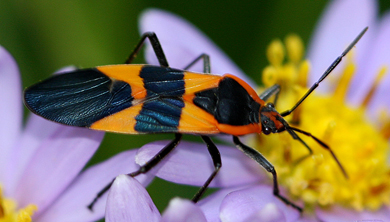Order: Hemiptera
Family: Lygaeidae
Genus: Oncopeltus
Oncopeltus fasciatus, the Large Milkweed Bug, feeds on milkweed plants, preferentially the flower buds and seed pods, which are rich in nutrients. This species occurs throughout the eastern and southwestern United States, westward to South Dakota, Minnesota, Iowa, Kansas, and Missouri. The specimen pictured here was found feeding on nectar in the Sarah P. Duke Gardens on the Duke University Campus. Oncopeltus fasciatus also occurs in Central America and the Caribbean. The tropical insects of this species are distinctly smaller than those that occur in the US. Oncopeltus cannot survive very cold winter temperatures and northern populations migrate south in the autumn. They overwinter in the southern Atlantic and Gulf coast states where they feed and breed and gradually migrate north again in the spring and summer. Oncopeltus can be easily reared in captivity, and laboratory studies have shown that its migratory behavior is controlled by juvenile hormone, the same hormone that also controls metamorphosis in larvae and reproduction in adult insects.

Oncopeltus fasciatus – Large Milkweed Bug

Oncopeltus fasciatus – Close up of the venter, rostrum, and head

Oncopeltus fasciatus – Feeding on a flower
Oncopeltus fasciatus on Bugguide.net
Oncopeltus fasciatus on Wikipedia
Sources
(2) Rankin, M.A. and L.M. Riddiford, The significance of hemolymph juvenile hormone titer changes in the timing of migration and reproduction in adult Oncopeltus fasciatus, J. Insect Physiol, vol. 24, (1978), pp. 31-38.
(3) Triplehorn, C.A. and N.F. Johnson, Borror and Delong’s Introduction to the Study of Insects, 7th ed., (2005), Thomson Brooks/Cole.
